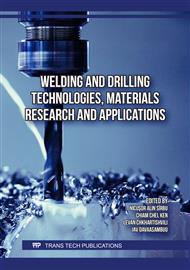p.3
p.17
p.23
p.31
p.41
p.49
p.59
p.73
Process Parameters Testing for Various Aluminium Alloys Using Laser Beam Welding
Abstract:
Laser beam welding (LBW) is an advanced welding technique based on keyhole welding, which makes use of a laser in order to join metals or thermoplastics. LBW is employed mainly in high volume applications which require high precision using automation, such as the automotive industry. The weldability, welding speed and penetration depth is mostly dependent on the power supplied to the laser, but the material and thickness of the workpiece also influences these parameters. This paper will present how various welding parameters such as power, frequency, the shape and size of the focal point affect different types of aluminium alloys, in an attempt to find the ideal parameters for the 5083 and 6082 aluminium alloys.
Info:
Periodical:
Pages:
17-21
Citation:
Online since:
November 2025
Authors:
Keywords:
Price:
Сopyright:
© 2025 Trans Tech Publications Ltd. All Rights Reserved
Share:
Citation:


